Discharge stains on underwear are a common concern for women—but fear not! Whether you’re dealing with rust-coloured stains on dark knickers or yellow marks on white panties, this guide teaches you everything on how to remove discharge stains from underwear effectively.
In this article, we explore a simple method using five different stain-removal options for you to choose between.
Using the proper techniques, you can successfully remove stains while preventing damage to delicate fabrics like lace, mesh, and silk.
With our expert advice, you can keep your intimates fresh and clean and ensure they stand the test of time.
How Do You Get Rid of Vaginal Discharge Stains?
To remove discharge stains from underwear, follow these steps:
Step 1: Tackle the stain immediately
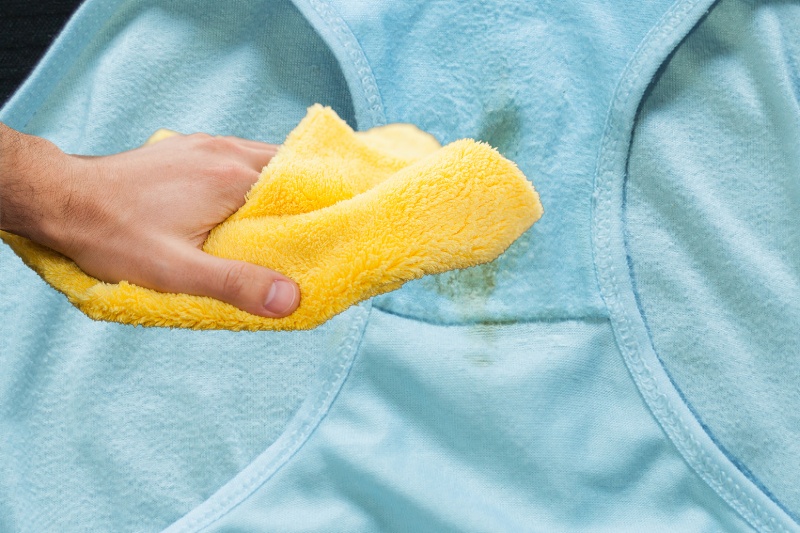
The key to successfully removing any stain is to act quickly. As soon as you notice the discharge stain on your underwear, try to treat it as soon as possible. Refrain from throwing your undies in the laundry basket, and get to work immediately.
If the stain is fresh, begin by blotting it gently with a clean cloth to remove excess discharge.
Ensure you use a blotting rather than a rubbing motion to avoid damaging the delicate material. Blotting also helps stop you from spreading the stain or pushing the discharge deeper into the fabric.
Having removed the excess, rinse the affected area with cold water to prevent the stain from setting.
We cannot stress the importance of using cold water when rinsing your underwear. High temperatures cause the proteins in organic stains like discharge to bind tightly to fibres, making them almost impossible to remove. In contrast, cold water helps to lift the discharge from the material.
Step 2: Use a stain remover
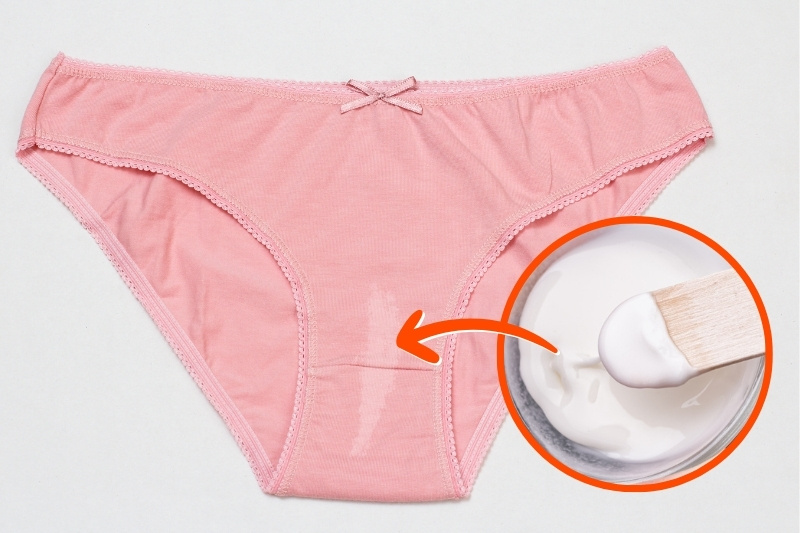
If the discharge mark is still visible after rinsing, apply a stain remover or pre-treatment product directly to the stained area.
Choose a product that is suitable for protein-based stains like discharge. Some of the best options include:
- Commercial enzymatic cleaners
- Bicarbonate of soda cleaning paste
- Lemon juice (light underwear only)
- Hydrogen peroxide (light underwear only)
Top Tip: We have more detail on these stain removers further down the article, so keep reading for help choosing the best option for your underwear.
Once you have applied the stain remover, gently rub it into the stain using your fingertips or a soft brush. Avoid using harsh motions that could damage the delicate fabric.
Step 3: Soak and wash your underwear
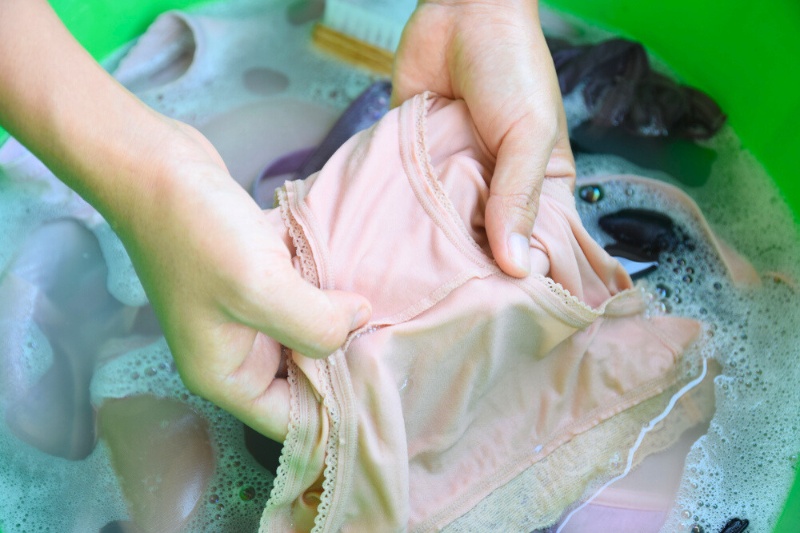
After pre-treating the stain, fill a sink or bucket with cold water and a small amount of mild laundry detergent.
Place the discharge-stained underwear in the soapy solution and let it soak for at least thirty minutes to help lift the stain.
After soaking, launder the underwear according to the instructions on the care label.
Many pairs of knickers can be washed in the washing machine, but others must be hand-washed:
- Machine washing: If laundering in your washing machine, use a setting for delicate clothes. Also, although underwear should be washed at high temperatures, it’s essential to continue to use cold water at this stage. Hot water can set the stain, so use cold water for the initial wash.
- Hand washing: If hand washing your underwear, refill the bucket or sink with clean, cold water and add some more detergent. Gently squeeze the knickers and rub at the stained area before rinsing them under cold water and ringing out the excess water.
Whether using a washing machine or washing by hand, we recommend using an enzyme-based detergent, as enzymes are effective at breaking down protein-based stains like discharge.
Step 4: Check and repeat if necessary
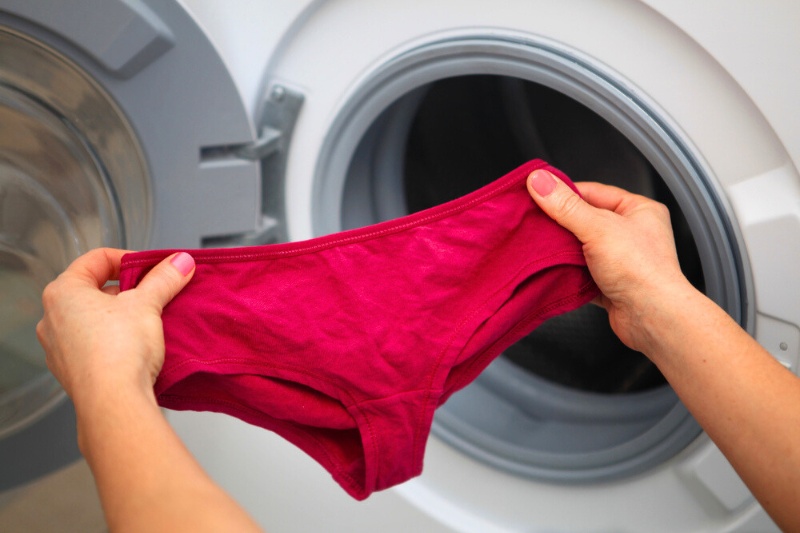
After washing, check to see if the discharge stain is still present. If it’s gone, you can proceed to dry the underwear as usual.
If the stain is still visible, repeat the pre-treatment and laundering steps until the stain is removed entirely.
Avoid putting the underwear in the dryer until the stain is completely gone, as heat can set the stain.
However, if the stain persists after multiple removal attempts, try hanging your underwear in direct sunlight.
The UV rays in sunlight act as a natural bleaching agent and can help fade and remove stubborn stains.
Step 5: Bleach your underwear (for white underwear)
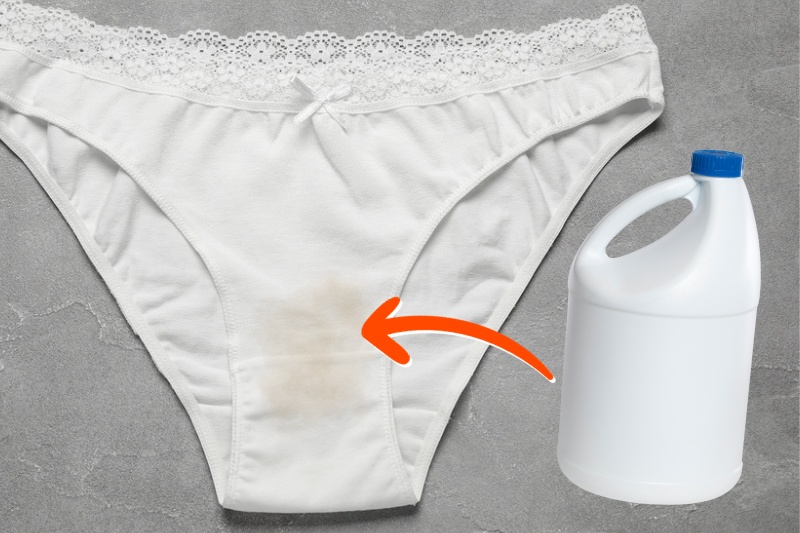
For particularly stubborn discharge stains, you might need to use something a little stronger. For example, you can use a small amount of chlorine bleach in cold water to remove the stain.
However, bleach can easily damage delicate materials if not used properly, so err on the side of caution.
Always follow the instructions on the bleach bottle regarding dilutions and check your underwear’s care label to ensure it won’t damage the fabric.
The colour of your underwear is also important. Generally, if the underwear is white and made of cotton, it can tolerate bleach.
If in doubt, refrain from using bleach on your delicates and take your underwear to a professional cleaner specialising in stain removal.
What Gets Rid of Discharge Stains?
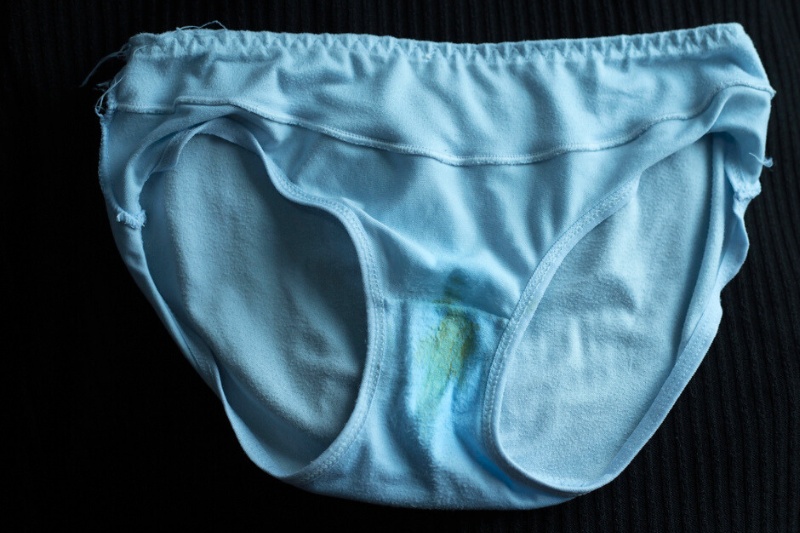
We have already mentioned four effective cleaners that get rid of discharge stains: enzymatic cleaners, bicarbonate of soda, lemon juice, and hydrogen peroxide.
Here’s a little more information on each of these stains and which you should use:
- Enzymatic cleaners: Enzymatic cleaners can be purchased from most British supermarkets. They’re highly effective at removing organic stains like discharge, but always check what fabrics they can be used on. Underwear is commonly made from delicate materials like lace, mesh, and satin, which may require specialised cleaners.
- Bicarbonate of soda: Bicarbonate of soda, also known as baking soda, is a mild abrasive and can help with stain removal without being too harsh on delicate materials used for underwear. To use, mix a small amount of bicarbonate of soda with water to form a thick paste (the consistency should be similar to toothpaste) and apply it to the stain.
- Lemon juice: Lemon juice is naturally acidic and can help remove organic stains—simply dilute with an equal amount of water and apply. However, exercise caution when using lemon juice on delicate fabrics like lace, especially if the material is black. Lemon juice, like other acids, has the potential to lighten or bleach the fabric.
- Hydrogen peroxide: Hydrogen peroxide is a common stain remover and disinfectant that effectively treats stains like discharge. However, like lemon juice, hydrogen peroxide is a bleaching agent and should be used cautiously on coloured and delicate fabrics. If using hydrogen peroxide, always dilute it with water in a 1:1 ratio to reduce its strength.
Why Does Discharge Stain?

We all know what discharge is—it’s a natural and healthy occurrence in the female reproductive system.
It’s the body’s way of maintaining a clean and healthy environment in the vagina by flushing out dead cells and bacteria. But why does it stain underwear?
Primarily, discharge stains are related to pH. The normal pH of vaginal discharge typically ranges between 3.8 and 5.0, which is on the acidic side.
This creates an acidic environment inside the vagina, helping to maintain a healthy balance of bacteria and yeast. In other words, it is crucial in maintaining optimal vaginal health.
However, this natural acidity can interact with the dyes and fabrics of underwear, leading to discolouration or stains over time.
Black or dark-coloured knickers are often marked with orange or rust-coloured stains as the fabrics are bleached, whereas white or light-coloured pants are often marked with pale yellow stains.
Additionally, the longer the discharge is in contact with your underwear, the more likely it is to stain. Vaginal discharge changes consistency throughout the menstrual cycle.
The type that typically causes the most staining on underwear is often the thicker, heavier, and more viscous discharge. It has a higher concentration of proteins that can adhere to fabric and lead to staining.
How Can You Prevent Vaginal Discharge Stains?
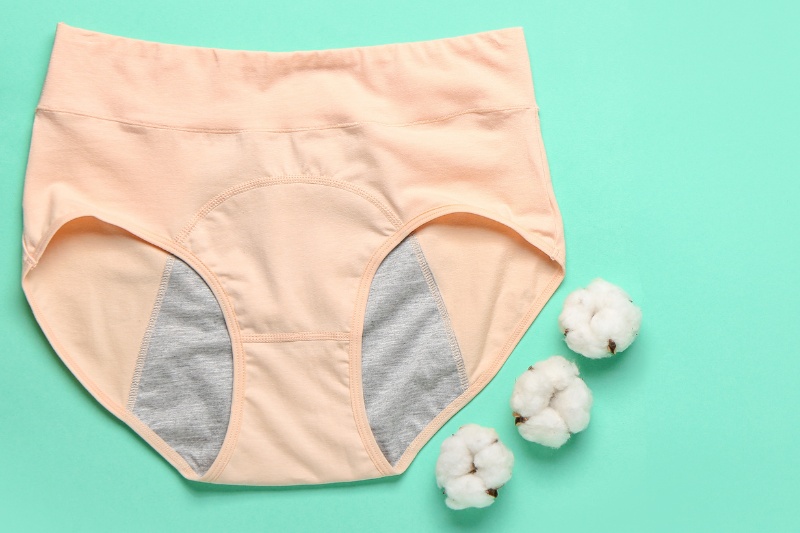
There is nothing you can do to stop vaginal discharge, and you shouldn’t want to. Although underwear stains can be unsightly, discharge is vital in maintaining vaginal health.
Therefore, preventing vaginal discharge stains on underwear involves maintaining good hygiene and taking steps to reduce the contact time the discharge has with your knickers.
Here are some tips and tricks that you can try at home today:
- Wear breathable fabrics: When buying underwear, opt for knickers made of breathable fabrics like cotton. Cotton allows air circulation, reduces moisture, and helps minimise the risk of stains and odours caused by discharge.
- Change underwear regularly: Change your underwear at least once or twice a day, especially if you notice increased discharge. Rinse the discharge off your old knickers when changing to limit the contact time your discharge has with the material.
- Use panty liners: Consider using unscented panty liners like TENA Discreet Ultra to help manage discharge, especially if you notice thicker discharge or a lot of it. Change them regularly to keep the area dry and reduce the risk of stains.
By adopting these habits, you can effectively manage vaginal discharge, reduce the risk of staining on your underwear, and maintain overall vaginal health.
However, if you experience significant changes in discharge, consult a healthcare professional for appropriate evaluation and guidance.

Hannah has a passion for cleaning. She worked her way around Australia by cleaning hostels in exchange for free accommodation and used her cleaning skills to bag a job as a chalet host for a luxury ski company in France.






